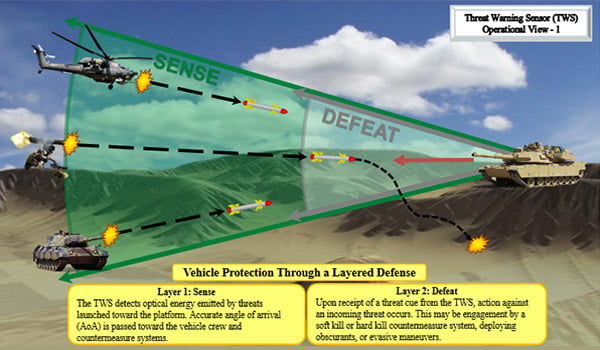
Aviation Survivability / By Mr. Ralph Troisio, Dr. Frances Bodrucki, Mr. Thomas Z. Provencher and Mr. Paul Restine: The development and proliferation of advanced anti-aircraft munitions including surface-to-air missiles (SAM), man-portable air-defense systems (MANPADS) and air-to-air missiles (AAM) present a significant threat to Army Aviation. These high-speed guided missile systems give crews little time to react to incoming threats and can prove fatal if not avoided or neutralized before impact. The U.S. Army Ground Combat Vehicles (GCVs) face similar threats in the form of Anti-tank Guided Missiles (ATGMs).

EWAGS GRAPHIC
A passive threat warning sensor (TWS) can increase aircraft and vehicle survivability by detecting and warning crews of incoming threats shortly after launch, giving crews more time to maneuver or cue countermeasures to defeat the incoming threat. Passive sensors offer a distinct advantage over-active sensors such as radar. Unlike radar systems, passive TWS systems are able to detect incoming threats without radiating any energy. This drastically reduces the equipped platform’s signature and therefore, its detectability.
Passive Threat Warning Sensors
Just like any pistol, rifle, shotgun, or other firearm seen in movies or television, anti-air and anti-armor threats produce distinct launch flashes when they are fired. That burst of light released from a launch produces a significant amount of energy that rapidly spreads out in all directions. Passive TWS use a combination of advanced optics, high resolution focal plane arrays and advanced signal processing to detect this energy long before the incoming threat can reach its target. Through the use of modern electro-optical imaging technology, this energy can travel several kilometers before reaching the vehicle and still be detected by a sensor.
Not all TWS systems are made to operate in the same wavelength band; some are designed to detect in a variety of bands across the electromagnetic (EM) spectrum. Operation in each band comes with its advantages and challenges. Infrared (IR) sensors can see far, but there is significant background clutter which results in the potential for more false alarms. Some passive sensors operate in the IR, by using two-color IR imaging techniques to reduce the background clutter that comes with IR imaging. Rather than operating in a single band, two-color IR imagers operate and sense light in two wavelength bands. These imagers take advantage of the spectral contrast between the two images produced at each wavelength to drastically reduce the amount of clutter.
Advanced hardware must be equipped with robust software and algorithms that utilize it to its fullest capability. These complex algorithms quickly and accurately distinguish incoming threats from background clutter. Algorithms are commonly used for object detection applications due to their ability to recognize trends and patterns as well as their ability to adapt with little to no human intervention. These algorithms rely on large sets of initial training data to learn but will continuously improve as they are presented more data over time. Algorithms are trained using launch signatures from a large array of recorded threat launches as well as many hours of recorded background data.
Passive Sensing on Army Aviation Platforms
Army Aviation invested in the Advanced Threat Warner (ATW) developed by Northrop Grumman Corporation (NGC). Since its initial investment, the U.S. Army has tested the ATW on several of its rotary wing platforms including the UH-60 Black Hawk and the CH-47 Chinook and has even fielded the system on the AH-64E Apache.
Before being adopted by the U.S. Army, the ATW was flown and demonstrated success on U.S. Marine Corps and U.S. Navy aircraft on the CH-53E Super Stallion, CH-53K King Stallion, and MV-22 Osprey. These aircraft as well as the AH-64E Apache paired ATW with the Department of the Navy Large Aircraft IR Countermeasure (DoN LAIRCM). This pairing enables these aircraft to use data collected by ATW to cue and direct countermeasures, increasing survivability of the aircraft.
Leveraging Army Aviation Efforts for Ground Combat Vehicles
Traditionally, threats to U.S. Army GCVs have been addressed by vehicle armor and hard kill (HK) active protection systems (APS). However, advancements in threat lethality have exceeded the practical limits of additional armor. This has led the Army to shift to a layered approach for ground platforms, which combines armor with threat sensors and countermeasures. This approach is a variant of an APS that protects GCVs using a combination of sensors, an electro-optic IR (EOIR) countermeasure and a central controller to detect, identify, engage, and ultimately neutralize incoming threats. The introduction of soft kill (SK) into the defense system allows for increased survivability as it is not round limited like HK.
Development of threat warning technology for use on GCVs comes with a unique set of algorithmic, integration and environmental challenges that make sensor requirements very different from those currently addressed in Army Aviation. For example, the ground environment generally has much more clutter in the field of view (FOV) than the air environment.
To support these efforts, the U.S. Army Combat Capabilities Development Command (CCDC) initiated science and technology (S&T) efforts under the Ground Survivability Active Defense (GSAD) as part of the Next Generation Combat Vehicle (NGCV) Cross Functional Team. This effort includes two FY20 start programs: Advanced Soft-kill Countermeasure (ASK-C) lead by Command, Control, Communications, Computers, Cyber, Intelligence, Surveillance, and Reconnaissance (C5ISR) Center and the Layered Soft-kill System (LSKS) led by Ground Vehicle System Center (GVSC). ASK-C feeds a passive TWS as well as soft kill countermeasure (SKCM) techniques and hardware to LSKS for a live fire demonstration in FY21. These systems will be integrated onto a vehicle solely for this test event. The goal of this event is to demonstrate the viability of a layered SK approach. Current planned follow-on programs will add to the layered approach (additional countermeasures, including smoke, expanded threat detection capabilities, etc.), including development of a TWS specifically for use on ground platforms. In the interim for the scheduled demo, the ATW was selected as the demo sensor for FY21 field event. The ATW was present at the GVSC FY19 SK Rodeo in a non-interference capacity. Of the sensors that were present, ATW was one of two that were already successfully fielded in some capacity.
As mentioned above, there are different challenges between the air and ground detection as unique problem sets in threat areas. The joint CCDC effort will demo the ground-adapted air sensor. This includes data collection in ground environments (particularly cluttered) to train and improve the algorithms from the air to work more efficiently in the ground environment, as well as hardware and environmental considerations to adapt the air sensor for functionality on a ground platform.
Path Forward
Current TWS efforts have the potential to expand the capabilities beyond those discussed above. For example, including a pointer/tracker to track threats in flight, as well as account for a wide variety of different scenarios such as situations where the launch flash cannot be detected. The Army is currently investigating the different wavebands mentioned above to determine if there should be a layered approach to sensing and what bands are most appropriate. The sum of all these efforts bring the Army one step closer to fielding passive threat warning on ground platforms.
Mr. Ralph Troisio is the chief, Dr. Frances Bodrucki and Mr. Thomas Z. Provencher are engineers, and Mr. Paul Restine is a subject matter expert of the Electronic Warfare Air/Ground Survivability Division of the Intelligence and Information Warfare Directorate (I2WD), Command, Control, Communications, Computers, Cyber, Intelligence, Surveillance, and Reconnaissance (C5ISR) Center, Combat Capabilities Development Command (CCDC) located at Aberdeen Proving Ground, MD.





















